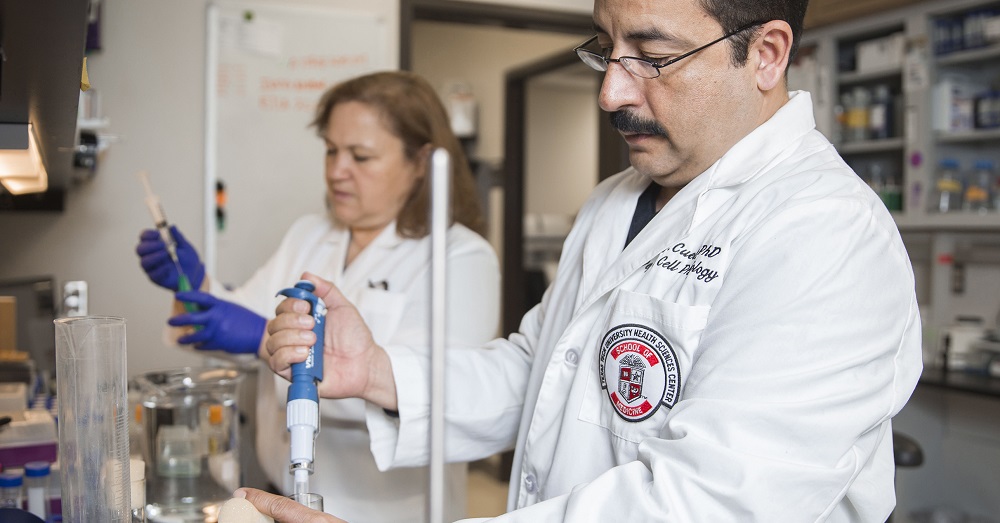TTUHSC’s Cuello Receives NIH Grant to Apply Novel Methods in Potassium Channel Study

The composition of every living cell includes small, highly specialized conduits known as potassium (K+) channels that are responsible for the extremely selective and rapid transport of K+ ions across cell membranes. The unique transport mechanism utilized by K+ ions defines the correct functional behavior of every living cell. In doing so, the K+ transport mechanism effectively controls a variety of very complex processes such as the normal electrical activity of brain neurons and the rhythmical beating of the human heart.
Luis Cuello, Ph.D., a professor in the Department of Cell Physiology and Molecular Biophysics at the Texas Tech University Health Sciences Center (TTUHSC) School of Medicine, has made a career of studying potassium channels. To continue his work, Cuello recently was awarded a five-year R35 MIRA (Maximizing Investigators’ Research Award) grant (“A comprehensive thermodynamic and structural characterization of ion channel function and its regulation by the lipid bilayer composition”) from the National Institutes of Health (NIH).
MIRA grants are not awarded for a specific research project. Instead, they allow an investigator to develop a plan describing where their research will be in 10 to 15 years and a model that provides a proposed framework for achieving that plan.
For Cuello, the journey to this latest NIH grant began in 2014 when there was a revolution in structural biology (the study of how biological molecules are built). That revolution centered around the use of a new technique called cryo-electron microscopy, known also as cryo-EM. Though it represented a novel step forward in determining the structure of biological molecules, the equipment necessary to perform cryo-EM is costly. Despite the cost, Cuello said many colleges and universities jumped into the technology, primarily for the opportunity to solve the structures of proteins: how they look, how they work and how they move.
“I am a structural biologist, but at the moment, we are a small institution, and to buy equipment like that involves a serious amount of money,” Cuello said. “At that time — it was 2015 or 2016 — I had to reinvent myself because I couldn’t just sit there and wait and hope for the new toy to be able to do my job; I cannot do that. So, we started to study the function of potassium channels from a thermodynamic point of view.”
One aspect that Cuello’s laboratory began to investigate was the thermodynamics underlying potassium channel ion selectivity and permeation. To do so, they utilized a process known as isothermal titration calorimetry to measure the binding of ligands, ions and drugs to potassium ion channels, which are Cuello’s field of expertise.
With the support of his department, which included the purchase of two machines to conduct his thermodynamic technique, Cuello continued his work for several years. As he did so, the mainstream technology eventually turned to expressing human ion channels in human cells, a process Cuello found less than ideal.

“The human cells grow very slow, they require very expensive grow media and it's a time-consuming approach,” Cuello explained. “You really have to be babysitting those cells, and they can get contaminated very easy, so there are many drawbacks about using that system.”
Rather than continuing his thermodynamic approach or using human cells, Cuello instead began trying to overexpress human ion channels — in this case potassium channels — in bacteria. He said investigators have tried for years to use bacteria because bacteria are economical, flexible, fast growing and more easily purified. Bacteria also can be produced in mass quantities, which is important in biophysical research.
“After many attempts — we have been going for almost 10 years — we finally cracked the code and we developed a methodology that is allowing us to express very large quantities of human potassium channels in bacteria,” Cuello said. “We’ve shown that we can purify them and that we can produce them in large quantities. And when we purify them, they retain their biological function, which opens the door for us to do many, many biophysical studies.”
Using his newly developed process, Cuello applied for a NIH MIRA grant, proposing to use his technology to target several human potassium channels that he can now express in bacteria. The channels he will target under the grant are relevant to diseases such as epilepsy, arrythmia, diabetes and others.
“By developing this technology, I’m purifying for this grant those channels that are important for the nervous system or for the heart,” Cuello added.
Cuello’s grant also includes funds for purchasing two very large pieces of equipment he will use to conduct those studies. He said the machines will bring a state-of-the-art technology to TTUHSC, and that the machines provided by his grant also will be available to other department colleagues as they conduct their own studies. One of the machines will be at the center of measuring the thermodynamics of ion binding in human potassium channels, something that has never been accomplished.
“These are very competitive grants because you have to compete with established investigators nationwide,” Cuello stressed. “You have to be highly productive and you have to show why what you are doing is so important.”
Cuello said the significance of his lab’s research was reinforced at a recent Biophysical Society meeting when he crossed paths with his NIH grant officer. The officer had recommended that Cuello be awarded the grant for which he was applying.
“He told me that the NIH are very impressed because our institution, compared to larger institutions, is doing this kind of work,” Cuello said. “In my humble opinion, all of us at TTUHSC should be happy and proud that the NIH recognizes the work that we have been doing here. It is recognition of the research that the underdog is doing here in rural Texas. We are doing things at TTUHSC that are important, and it is rewarding to see that recognition happen.”
